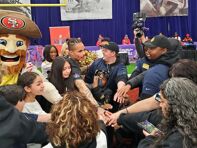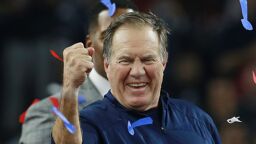It was a surreal moment to be watching CBS Sports’ NFL coverage this weekend and see a league-sponsored promo for a gay flag football league I co-founded almost 20 years ago. It shows how big things can emerge from something small.
I started playing flag football in 1989, four years after moving to Los Angeles. I was looking for an alternative to meeting people at the bars, in an era well before Grindr, Scruff or social media. I found a group playing at West Hollywood park and was amazed to be around other gay men who knew a “tight end” wasn’t just some sort of sexual slang.
I helped form a league in Los Angeles in the early 1990s, with our home field at Hollywood High, home of the Sheiks (named after a role made famous by silent film star Rudolph Valentino). The field was mostly dirt — on dry days, it resembled a dust bowl and on rainy days, a mud pit. But we loved it. Guys (and a few women) showing up to play flag football for hours didn’t get much better.
At the same time, I was also instrumental in getting flag football included as a sport in the 1994 Gay Games, four years after its debut at the Games in Vancouver (which used Canadian football rules like three downs instead of four).
Get off the sidelines and into the game
Our weekly newsletter is packed with everything from locker room chatter to pressing LGBTQ sports issues.
L.A. won the silver in 1990 and two teams from our league met for the gold medal at Gay Games 1994 in New York, where I threw the game-winning touchdown pass with a few plays remaining, one of my all-time athletic highlights.
At that time, the idea that gay men (soon joined by lesbians, trans and nonbinary players) would one day be celebrated by the NFL and CBS Sports was a pipe dream. Then (sadly as well as now), there were no out players in the league, but just as important, there was zero sense that anyone in the NFL cared a whit about gay people who loved football.
A turning point came in 2002, when Cyd Zeigler and I had an idea to have a gay flag football tournament at Hollywood High. Cyd and I met at WeHo Pride in 1996 when I was manning a booth for the L.A. flag football league. We became fast friends and he would come over on NFL Sundays and we would geek out on the games since I had “NFL Sunday Ticket.”
We also played a primitive NFL video game whose annoying theme music haunts me to this day since he won way more than me. And our being big NFL fans was a reason we started Outsports.
We grandly called our first tournament in 2002 the Gay Super Bowl, but later shortened it to Gay Bowl as to not run afoul of NFL copyright. There were three teams — L.A., San Francisco (we had been playing friendlies against them for years) and Boston. We played in the Hollywood High dust and had a blast on a day that ended with the players crammed into a hot tub at a West Hollywood hotel.
The next event, in San Francisco in 2003, grew to six teams as word spread about how much fun we had the year before. In 2004, the cities decided to form a body, the National Gay Flag Football League, and I was its commissioner for 10 years. When I left office, we had 30 teams at the Gay Bowl. Now it’s about 50 teams with several divisions, including a women’s event.
From such humble beginnings to having the NGFFL featured on NFL telecasts, with Patriots owner Robert Kraft a proud supporter, boggles my mind. It’s like the founders of the NFL in the early 1920s coming back and seeing what became of the small league they formed.
While I continue to lament the lack of out players in the NFL, regardless of the reasons, there is no doubt that at the league level, there has been a push for inclusion. Compared to when the NGFFL was formed 19 years ago, there are more out LGBTQ people in the NFL, in addition to people at CBS Sports (including friends like Theo Rabinowitz and Michael DeFusco) who made this video happen.
Seeing LGBTQ people playing football being affirmed by the most popular pro sports league in the country, as well as its TV home on Sundays, does mean something.
It’s something a younger me throwing passes on a beautiful L.A. fall day never thought I’d see.








































